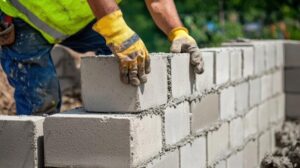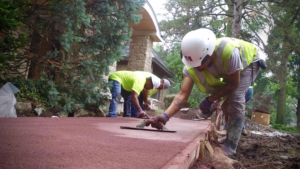Concrete Contractors McKinney TX are experts in constructing and repairing concrete structures. They also have in-depth knowledge of different types of concrete materials. They work with architects, engineers, and project managers to meet construction requirements.

Before choosing a concrete contractor, it is important to ask for referrals from friends and family. It is also necessary to compare quotes from multiple companies.
Concrete is a versatile construction material that can be used in many ways. It is often poured and formed to serve as the foundation of homes or industrial buildings, but it can also be used to create decorative elements like walkways and patios. Regardless of its purpose, it is vital that the work of concrete contractors conforms to building codes for safety and durability. Additionally, the finished product must look professional and visually appealing. Specialized concrete contractors have the skills and knowledge needed to provide high-quality results.
A qualified concrete contractor should have at least general liability insurance and workers’ compensation coverage. These policies protect both the contractor and the property owner in case of an accident during a project. It is also important to review a contractor’s past work before hiring them. In addition to checking credentials, it is also a good idea to verify whether the contractor has experience in the type of concrete work you need.
One of the core services that concrete contractors offer is mixing and laying concrete. This requires them to understand how to properly mix concrete to achieve the right consistency and accurately place it. They must also be proficient in using various formwork systems to shape the concrete as it sets.
Additionally, a concrete contractor should be familiar with the different finishes that can be applied to concrete projects. This includes brooming, stamping, and polishing techniques. These finishing touches can dramatically impact the aesthetic appeal of a finished concrete project. A skilled contractor will be able to choose the right materials and apply them in a way that will result in an attractive, durable finish.
Finally, a concrete contractor should be familiar with various rebar and reinforcement methods that can strengthen and improve the overall integrity of concrete constructions. Rebar and reinforcement increases the tensile strength of concrete, which is necessary for ensuring that constructions can withstand environmental stresses and maintain structural stability. This is especially important for commercial concrete construction projects, where the integrity of concrete structures can be affected by frequent traffic and exposure to extreme weather conditions.
Reputation
When it comes to home improvement projects, you want your concrete work to be structurally sound and professionally finished. Hiring a contractor that has a good reputation for quality work is a great way to ensure that your project is completed correctly and on time. You can determine a contractors reputation through their online reviews and ratings, or through personal referrals from friends and family. Local home improvement stores are also a good source of information about contractors in your area.
Look for a contractor that has a portfolio of completed concrete projects. This allows you to see firsthand the contractor’s craftsmanship and style of work. It is also a great way to evaluate the contractor’s ability to meet your specific project requirements. Often, concrete contractors will display their portfolios on their websites. However, if they do not, you can request samples of their work to assess their quality.
You should also ask a potential concrete contractor for references from previous clients. This will give you a better sense of their quality of work and their customer service skills. It is also a good idea to check out their website and social media accounts. A reliable concrete contractor will have a strong online presence with many positive reviews and testimonials.
Lastly, you should always get a comprehensive written estimate from any concrete contractor before starting a project. This should include a breakdown of costs for materials, labor, and timelines. This will allow you to compare estimates from different contractors accurately and avoid any unexpected expenses down the road.
You should also make sure that the concrete contractor you hire is licensed and insured. This is important because concrete work can be dangerous and requires special training. Hiring an unlicensed or insured contractor could lead to costly mistakes that will require expensive repairs. It is also a good idea to find out what type of warranties or guarantees they offer for their work. A detailed, long-term warranty is a good indicator of a concrete contractor’s commitment to quality and customer satisfaction. Moreover, it will help you to resolve any disputes that may arise during the course of the project.
Experience
The most experienced contractors will have a vast knowledge of different concrete construction techniques and building codes. They will also know how to deal with various weather conditions and other issues that might impact the completion of a project. This level of expertise can help them save you money by avoiding costly mistakes and saving time on rework.
In addition, contractors with a wealth of experience will be able to anticipate problems and find solutions quickly, which can make the difference between a successful project and an unsuccessful one. When evaluating potential contractors, look for projects they’ve completed recently or in the past five years and request references or access to their portfolios. This will allow you to assess their skill levels, reliability, and communication skills.
A reliable contractor will provide clear and detailed estimates that clearly outline the scope of work for your concrete project. They will also be able to establish a schedule and timelines for the project, keeping you updated as it progresses. Having open and transparent communication with your contractor will ensure that you are both on the same page throughout the process and that the final results match your expectations.
It’s important to note that although commercial concrete contractors may appear more expensive than DIY options, they offer a much higher quality of workmanship. This is primarily due to their deep understanding of the technology behind concrete and their ability to choose the right mixtures for each specific job, while still ensuring optimal strength and longevity. They are also constantly learning and updating their skills, as new technologies emerge in the industry.
The best way to find a reputable and professional concrete contractor is by getting referrals from friends, family, and colleagues who have worked with them in the past. You can also check online reviews and ratings, and visit local showrooms to compare products and prices. Choosing the best contractor can make your project easier and more cost-effective, so be sure to take the time to evaluate several candidates and discuss their experiences with you. It’s also a good idea to ask about their warranties, as this can be an important factor in making your decision.
Communication skills
The success of any construction project hinges on the ability to communicate effectively. This is especially true for concrete projects, which require precision and attention to detail. For this reason, it’s important to choose a contractor with excellent communication skills that will keep you updated on the status of your project and ensure that the finished product meets your expectations.
During your consultation, ask contractors about their communication styles and methods. Look for open and honest answers that demonstrate a dedication to establishing a strong working relationship. If you encounter a contractor who is unresponsive or unable to clarify your questions, it may be time to consider other options.
In addition to effective communication, the right contractor will have a deep understanding of the technical aspects of concrete work. For example, they should be able to explain the different concrete mixtures and curing processes. This is an indication that they have a thorough knowledge of the industry and are dedicated to staying up-to-date with the latest advancements.
When choosing a concrete contractor, it’s also a good idea to request references from past clients. This will give you a firsthand account of the contractor’s abilities, and it can help you determine whether their services are right for your project. Be sure to ask about the contractors’ ability to meet deadlines and how they handled unexpected challenges during the construction process.
Lastly, make sure that the contractor has adequate insurance coverage to protect yourself and your property in case of damage or injury. Ask to see proof of their liability insurance and worker’s compensation, and make sure that their policy is up to date.
Once you’ve found a concrete contractor that fits your needs, it’s important to establish clear communication channels and set out your project’s goals from the start. Clearly define the scope of your project and establish a budget, making sure to include any potential contingency funds. Additionally, request comprehensive estimates from contractors with a breakdown of costs, materials, and timelines. This will prevent any misunderstandings and ensure that the final result is in line with your vision.

